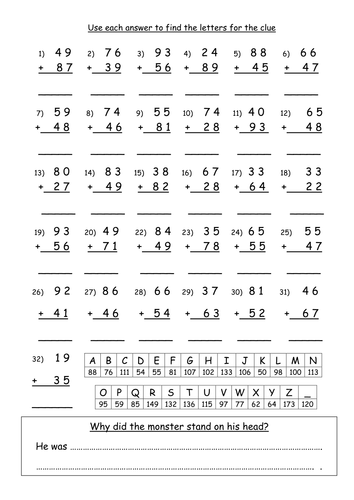Crack The Code Worksheet Math

Secret Code Secret Code It’s time to crack the ‘Secret Code’! The ‘Secret Code’ is a challenging math worksheet for kids with various addition and subtraction problems. The twist in this worksheet is that the answer to each problem represents a certain letter. Kids need to solve all problems correctly and use the key provided to find out the secret message. This free and printable addition and subtraction worksheet is a great way for homeschooling parents and teachers to give the little ones some additional!

When you think of spies and secret agents, you might think of lots of things; nifty gadgets, foreign travel, dangerous missiles, fast cars and being shaken but not stirred. You probably wouldn't think of mathematics. But you should. Cracking codes and unravelling the true meaning of secret messages involves loads of maths, from simple addition and subtraction, to data handling and logical thinking.
Crack the Code. 4.7 15 customer reviews. My primary objective is the COMMON CORE and bridging the gap between Math and. Crack the Code. 4.7 15 customer reviews. Students will perform a total of 25 math problems that spans the four. Math Fundamentals PoW Packet Crack the Code. Our group used the Activity Series worksheet that our teacher gave us and we listed our. In Crack the Code.
In fact, some of the most famous code breakers in history have been mathematicians who have been able to use quite simple maths to uncovered plots, identify traitors and influence battles. The Roman Geezer Let me give you an example. Nearly 2000 years ago, Julius Caesar was busy taking over the world, invading countries to increase the size of the Roman Empire.
He needed a way of communicating his battle plans and tactics to everyone on his side without the enemy finding out. : Appcrash Ac4bfsp.exe. So Caesar would write messages to his generals in code. Instead of writing the letter 'A', he would write the letter that comes three places further on in the alphabet, the letter 'D'. Instead of a 'B', he would write an 'E', instead of a 'C', he would write an 'F' and so on. When he got to the end of the alphabet, however, he would have to go right back to the beginning, so instead of an 'X', he would write an 'A', instead of a 'Y', he'd write a 'B' and instead of 'Z', he'd write a 'C'. Complete the table to find out how Caesar would encode the following message: Caesar's message A T T A C K A T D A W N B U C V Coded message D When Caesar's generals came to decipher the messages, they knew that all they had to do was go back three places in the alphabet.
Have a go at trying to work out these messages which could have been sent by Caesar or his generals: hqhpb dssurdfklqj wkluwb ghdg uhwuhdw wr iruhvw Easy as 1, 2, 3 This all seems very clever, but so far it's all been letters and no numbers. So where's the maths? The maths comes if you think of the letters as numbers from 0 to 25 with A being 0, B being 1, C being 2 etc. Then encoding, shifting the alphabet forward three places, is the same as adding three to your starting number: A B C D E F G H I J K L M N O P Q R S T U V W X Y Z 0 1 2 3 4 5 6 7 8 9 10 11 12 13 14 15 16 17 18 19 20 21 22 23 24 25 For example, encoding the letter 'A' is 0+3=3, which is a 'D'. Coding 'I' is: 8+3=11, which is 'L'. However, you do have to be careful when you get to the end of the alphabet, because there is no letter number 26, so you have to go back to number 0.
In maths we call this 'MOD 26', instead of writing 26, we go back to 0. Have a go at coding your name by adding 3 to every letter.
Then have a go at coding your name by shifting the alphabet forward by more places by adding greater numbers eg adding 5, then adding 10. Then have a go at decoding. If your letters are numbers and encoding is addition, then decoding is subtraction, so if you've coded a message by adding 5, you will have to decode the message by subtracting 5. If you've got the hang of coding messages by shifting the alphabet forward, then you might have realised that it is actually pretty simple to crack this type of code. It can easily be done just by trial and error. An enemy code breaker would only have to try out 25 different possible shifts before they were able to read your messages, which means that your messages wouldn't be secret for very long. So, what about coding messages another way?
Instead of writing a letter, we could write a symbol, or draw a picture. Instead of an 'A' we could write *, instead of a 'B' write + etc. For a long time, people thought this type of code would be really hard to crack. It would take the enemy far too long to figure out what letter of the alphabet each symbol stood for just by trying all the possible combinations of letters and symbols. There are 400 million billion billion possible combinations!



